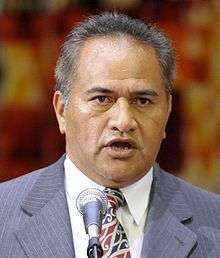Tuku Morgan
| Tukoroirangi Morgan | |
|---|---|
 Tukoroirangi Morgan in 2009 | |
| Member of the New Zealand Parliament for Te Tai Hauāuru | |
|
In office 1996–1999 | |
| Preceded by | New constituency |
| Succeeded by | Nanaia Mahuta |
| 4th President of the Māori Party | |
|
Assumed office 16 Jul 2016 | |
| Preceded by | Naida Glavish |
| Personal details | |
| Born |
Tukuroirangi Morgan 7 October 1957 Auckland, New Zealand |
| Political party | Māori Party |
| Other political affiliations |
New Zealand First Mauri Pacific |
Tukoroirangi "Tuku" Morgan (born 7 October 1957) is a New Zealand Māori politician and former broadcaster.
Early life and family
Born in Auckland on 7 October 1957, Morgan affiliates to the Tainui iwi confederation. He was educated at St Stephen's School, Bombay from 1970 to 1971, and Huntly College from 1971 to 1976. He then gained a Diploma of Teaching, and taught English and Māori studies at Huntly College from 1980 to 1982, and Birkdale College (1982).[1] His brother-in-law is Tau Henare.[2]
Broadcasting
Morgan worked as news and current affairs reporter at both Television New Zealand and TV3. He was also head of sport, youth and current affairs programmes at the short-lived Aotearoa Television Network.[1]
Member of Parliament
| Parliament of New Zealand | ||||
| Years | Term | Electorate | List | Party |
| 1996–98 | 45th | Te Tai Hauāuru | 10 | NZ First |
| 1998–99 | Changed allegiance to: | Mauri Pacific | ||
Morgan was first elected to Parliament in the 1996 elections as the New Zealand First MP for Te Tai Hauāuru. New Zealand First captured all five Māori seats in the 1996 election (including Te Tai Hauāuru) - Morgan and the other four Māori MPs became known as the Tight Five.[3]
During his term in Parliament he was involved in a number of controversies. One scandal in 1997 revolved around his spending NZ$4000 of Aotearoa Television funds on clothes including a pair of $89 underpants.[4][5]
Morgan resigned from New Zealand First on 18 August 1998, becoming an independent MP.[1] He later joined the newly formed Mauri Pacific.[3] In the 1999 elections, Morgan was ranked second on Mauri Pacific's party list, and contested the Te Tai Hauāuru seat again, but was not returned to Parliament. He then returned to television and film production.
Life after parliament
He was chair of Te Arataura, the Waikato-Tainui executive board, from 2006 until 2012, except for a period in 2004 when he was removed from office because of a criminal conviction for obstructing police during a protest march in the 1980s.[6] He is a director of Auckland Council Property, a council-controlled organisation of the Auckland Council.[7]
In 2015 he became the Māori Party's co-chair of the Hauraki-Waikato electorate.[8] In July 2016 he was elected as president of Māori Party.[9][10]
References
- 1 2 3 Taylor, Alister, ed. (2001). New Zealand Who's Who Aotearoa 2001. Auckland: Alister Taylor Publishers. ISSN 1172-9813.
- ↑ Stokes, Jon (4 February 2006). "Protester's flame still burns, if less brightly". The New Zealand Herald. Retrieved 19 February 2010.
- 1 2 Herrick, Linda (29 December 2001). "Tuku Morgan goes from Parliament to Ponsonby Rd". The New Zealand Herald. Retrieved 19 February 2010.
- ↑ "'Close eye' on TV grant to Tuku Morgan". The New Zealand Herald. 29 January 2002. Retrieved 19 February 2010.
- ↑ "Mallard tries to stay afloat". Sunday News. 27 October 2007. Retrieved 19 February 2010.
- ↑ Tahana, Yvonne (14 February 2012). "Dumped Waikato-Tainui iwi leader plans litigation". The New Zealand Herald. Retrieved 31 March 2012.
- ↑ "Te Arataura members appointed to Auckland CCOs". Scoop. 3 September 2010. Retrieved 14 December 2010.
- ↑ Maori Party weigh in on Labour's reshuffle nzherald.co.nz, 1 December 2015
- ↑ Young, Audrey (16 July 2016). "Tukoroirangi Morgan elected as Maori Party president". The New Zealand Herald.
- ↑ Haunui-Thompson, Shannon (16 July 2016). "Tuku Morgan: 'One goal' for Māori Party". Radio New Zealand.
| New Zealand Parliament | ||
|---|---|---|
| New constituency | Member of Parliament for Te Tai Hauāuru 1996–1999 |
Succeeded by Nanaia Mahuta |